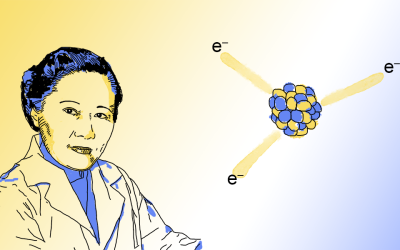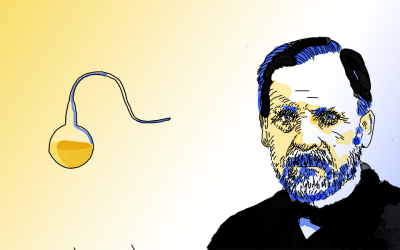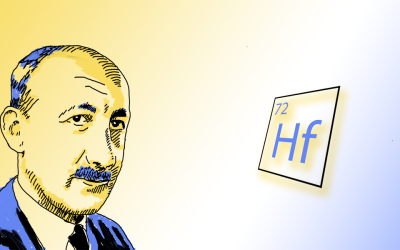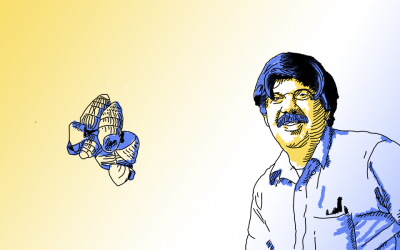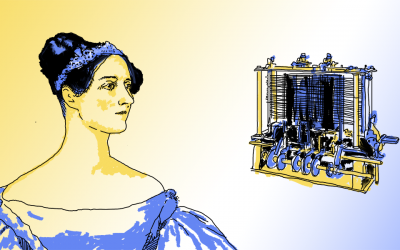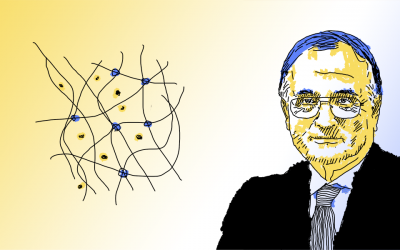Illustration by Kieran O’Brien
From the Big Bang to intelligent life, how did the universe come to be? This is a question John Mather, senior astrophysicist at NASA’s Goddard Space Flight Center and senior project scientist on the new James Webb Space Telescope, has spent his career trying to answer.
As a result of his pioneering work, Mather, along with George Smoot of the University of California, were awarded the 2006 Nobel Prize in Physics for their work on the Cosmic Background Explorer Satellite (COBE), which they used to measure heat radiation from the Big Bang.
Beginnings
Born in 1946 in Roanoke, Virginia, Mather grew up on an agricultural research farm at Rutgers University in New Jersey. Coming from a family of scientists and teachers, he recalls his interest in science started at an early age. From building one-tube radios to assembling small refractor telescopes and assembling a science fair “robot” from a vacuum cleaner (which unfortunately never worked), he showed an early aptitude. “I had a lot of opportunity to learn science, even in our very rural setting,” he wrote in his Nobel Prize biography.
After studying at Swarthmore College, Mather planned to complete his graduate work at Princeton, but a bit of persuading by a friend on the warmer West Coast helped change his course. “A friend, Ted Chang, who was my friend at Assumption College for a high school summer, sent me a photo of himself sitting on the fountain in Berkeley in January, wearing short sleeves,” he said. “He sent me an application form for a summer job, and I went.”
There he worked in the Lawrence Berkeley Laboratory with Henry Frisch, developing control electronics for a spark chamber. When it came time to go back to the East Coast, Mather had changed his mind and remained at Berkley.
It was in 1970, while looking for a topic for his thesis, that Mather became interested in a proposal by physicist Charles Townes who was investigating cosmic background radiation — heat produced at the beginning of time that still permeates the universe.
A (brief) history of cosmic background radiation
Cosmic background radiation was a newly discovered phenomenon first detected in 1963 by Arno Penzias and Robert Wilson, who were originally trying to map radio signals from the Milky Way.
Initially, Penzias and Wilson thought their antenna was picking up background noise, like static on a radio, which was interfering with their measurements. They found it puzzling because the noise could be detected in all directions — there wasn’t a specific source they could identify.
Prior to its discovery, there existed two prominent theories about the origin of the universe. The first was that the universe was homogeneous and static and would remain that way forever. The second — more controversial idea — was that the universe was expanding, and at some point in the distant past, it had been infinitely dense. The birth of the universe as we know it took place during a cataclysmic explosion called “the Big Bang”.
It was around this time that Princeton physicist Robert Dicke had theorized that if the universe was created according to the Big Bang theory, a low-level background radiation would exist throughout it as it expanded in all directions.
Penzias and Wilson were put in touch with Dicke, and the two teams confirmed the existence of this cosmic background radiation — proof of the Big Bang. Penzias and Wilson received the Nobel Prize in Physics in 1978 for their serendipitous discovery.
Struggles to get off the ground
In addition to providing evidence of the Big Bang and an expanding universe, mapping and measuring the temperature and fluctuations of cosmic background radiation would help scientists learn how more about the early universe, as well as how stars, planets, and galaxies had formed.
Mather and his fellow graduate students attempted to do this using a newly developed far infrared spectrometer. “This was the beginning of a baptism by fire, in the art of building instruments that would work in remote and hostile locations,” recalled Mather. “It was a time to learn something of almost every area of engineering, from mechanical to optical to cryogenics to electronics. I’m afraid that my skill was stronger in understanding than it was in implementation, and it’s a true story that the antenna on the balloon payload fell off while it was on the launch pad. It was my solder joint that failed. Fortunately, this fault was noticed, and the payload was launched successfully.”
Attempts were made on a mountaintop and then by launching the spectrometer into the upper atmosphere using a weather balloon. However, these strategies proved unsuccessful, and the team couldn’t overcome interference as a result of the Earth’s atmosphere. “It was an awful feeling, one that stayed with me for the rest of my life, and it was one of those ways of learning what one does not want to learn. Murphy’s law had been proven one more time,” he lamented.
He wrote up his thesis on the ground-based work, spectrometer, and balloon design, and went on to a post-doctoral researcher position at the Goddard Institute for Space Studies at Columbia University in New York City.
Studying with Pat Thaddeus, Mather said he had hoped to enter a new field of study, leaving his work on background radiation behind. But in 1974, NASA issued a call for proposals for upcoming satellite missions. “My optimism was returning, and when Pat asked for ideas, I cheerfully asserted that my thesis experiment would have worked a lot better in space,” he said.
Data gathered by the COBE satellite cements the Big Bang Theory
In 1976, NASA began to move forward with the Cosmic Background Explorer (COBE) mission, based on Mather’s proposal, and in which he was named Study Scientist. The goal was to measure the spectrum of diffuse radiation and map it across the sky to gain new knowledge about the early universe.
The Big Bang Theory holds that the early universe was once very hot — given that all matter and energy were concentrated to a single point — but cooled following this first explosion and with its subsequent expansion. Thermal radiation from this time is therefore a kind of fossil evidence.
This heat would have traveled for billions of years before reaching Earth, resulting in a redshifting or lengthening of its wavelengths into the microwave region of the spectrum. Scientists had previously predicted that by now, the radiation’s temperature would have dropped to roughly 3 Kelvin.
Over the course of a decade, Mather led a team of scientists in developing state-of-the-art instrumentation to measure this radiation — the oldest light in the universe. With the satellite’s launch in 1989, the field of cosmology was forever changed.
COBE was able to measure the spectrum of cosmic background radiation, which allowed the team to confirm what had been predicted by theory: that it fit a black body curve and had a temperature of 2.735 Kelvin.
A blackbody is an object with a constant temperature that absorbs all radiation that hits it. To have a blackbody spectrum, an object has to be opaque, non-reflective, and isothermal. The universe, today, is not a blackbody, but shortly after the Big Bang, it was dense, hot, and homogenous. Light could not move freely, making it, by definition, a light-absorbing blackbody. Cosmic background radiation is a remnant from this time, and measuring it so accurately helped scientists lay to rest the Steady-State Model of the universe.
COBE also measured small fluctuations background radiation intensity, revealing new data on the formation of celestial objects such as galaxies and stars.
The journey was a difficult one, with Mather outlining the challenges and technical problems he and his team had to solve before finally getting COBE into orbit in his Nobel lecture, given in 2006.
Though he accepted the award, Mather staunchly advocates for the teamwork that goes into making discoveries such as these possible. “I didn’t win a Nobel Prize; we won a Nobel Prize. Anything that I do is done by many, many people together,” he said during a 2018 NEAF lecture. The team that built the COBE satellite included about 1,500 people.
Mather donated his prize money to create a scholarship program, which supports graduate student fellowships and travel grants for NASA and Goddard Center interns, among other projects.
James Webb Space Telescope
Since 1995, Mather has been leading the development of the world’s most sophisticated orbiting telescope: the James Webb Space Telescope. This, he says, has been his “major passion”.
Set to launch at the end of this month, it will be the first orbiting telescope to image the universe in the infrared spectrum, enabling scientists to see farther into the cosmos than ever before.
In addition to better understanding the birth of stars, planets, and galaxies, searching for alien planets, and exploring the universe when it was just 150 million years old, Mather says that Webb will no doubt lead to new and unexpected discoveries.
“I’m pretty confident there will be surprises out there,” he said, “things that will be worth all this work.”
Read more Pioneers in Science stories here.












